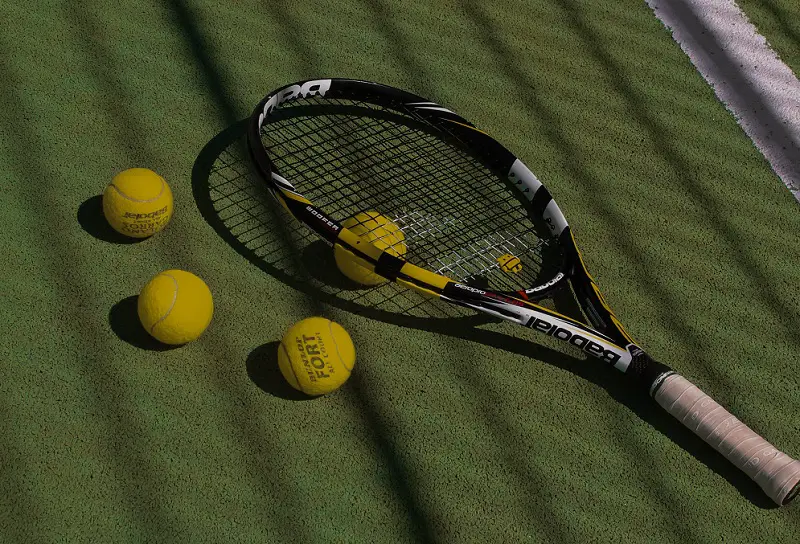Tennis players love their rackets and once they get comfortable with them, they just don’t want to part with them. But how long can a tennis racket last? Can they actually last forever or will they eventually ‘tire’?
Let’s get straight down to answering the question before we delve deeper into the issue.
How long do tennis rackets last? Top players, playing professional tournaments, need to change their racket frequently, but for someone who is playing for recreation, maybe once or twice a week, can continue to keep the same racket for a longer time, which could even last from five to 10 years in case the racket isn’t broken or cracked.
They just need to make sure that they take good care of their racket and keep restringing it from time to time. They may also need to change the bumper guard and the grommets whenever they see the need to change them.
So what is restringing? What are bumper guards and grommets? And why do tennis rackets need to be changed at all? Keep reading and you will find all your answers here.
Table of Content
Why the Need to Change a Tennis Racket?
Racket frames are made of graphite or a composite material with graphite as the primary material, and is held together with resins. With ball striking the string bed, the string and the frame keep losing their firmness.
Each time a ball strikes the racket, the frame bends backward to absorb the pressure and then forward to transfer the energy to the ball.
The more powerful shots you play, the more beating the frame takes. Eventually over time, the frame starts to become softer as the interaction between the graphite and resin starts to loosen, thus lowering the performance of the rackets.
As the frame becomes soft, the power generated by the racket reduces. While the frame loses its stiffness (read what’s a racket’s stiffness here) gradually, once it becomes soft one must start contemplating changing the racket.
Also Read:
- Why do Tennis Players Break Their Rackets in a Match?
- Why do Tennis Players Adjust Their Racket Strings?
Factors That Decide a Tennis Racket’s Life
Type of Material Used in a Racket
Rackets made of wood or or other elements surely don’t last long.
Long ago, even professionals used frames made of wood, but once racket makers introduced graphite frames, it has completely replaced the wooden frames.
Graphite has better longevity as it has better ability to absorb shock, plus it is also lighter.
So if one is using frames made of wood or another material, they may soon want to switch to graphite frames, thus needing a change of racket.
Weather Conditions
Extreme weather conditions can also have an adverse affect on your rackets. Extreme high temperatures can damage the handle, distort the body and loosen the strings.
Strings may even break down in extreme heat. While extreme cold may impact the string too, but the damage caused is still lesser than the one caused by heat.
Therefore, it is always advisable to keep the racket in normal, room temperature as long as possible.
Change in Playing Style Forcing Change of Racket Type
There are different kinds of rackets to suit one’s needs.
A beginner will more often use rackets that have more power. It’s the time they are developing their skills and don’t have a lot of control over their game.
Power rackets have oversize heads, they are longer and have stiff frames, which don’t bend a lot, thus these rackets generate a lot of power. So these rackets even suit players who are short and can’t generate a lot of power of their own.
As one develops the skills, they will quickly want to transition from power rackets to control rackets. These rackets have smaller heads, are heavier than the power rackets and the frames are more flexible.
They don’t generate a lot of power of their own and rely on the power of the player, but give more control to players, who can now play a range of strokes by varying their swing.
Then there are tweeners, or rackets that sit between the power and control categories.
For professional players, there are “modern player’s rackets” which are similar to tweeners but have been built to support players who rely on heavy top spin.
Different rackets suit different styles of play. So if an injury forces you to make a change in the way you play, you may have to switch to another racket; or maybe your game has developed and you are now ready for an upgrade, in that case as well, you should think of making the switch.
There may not be anything wrong with the racket you are already using but the situation demands a change of racket as it would best suit your game.
How Can You Extend Your Tennis Racket’s Life?
Here’re some of the things you can do to make sure you aren’t left with needing to change your racket more regularly than you should.
Restringing
It is important for players to get their rackets restrung from time to time.
Strings are the most important component of a racket and it’s paramount to look after them.
Strings tend to lose tension with time and it starts to show on one’s game as the player begins losing control of the shots. Just when that starts to happen one needs to get the racket restrung.
So how often should one get the racket restrung? One rule that tennis players follow is if you play say twice a week then get the racket restrung twice in a year. If you play for three times in a week, then get the racket restrung thrice in a year and likewise.
But while restringing is important, it is also worth noting that each time you cut the strings and restring the racket the frame undergoes slight distortion and the more one restrings a racket, the chances are that sooner the frame would go softer.
Here is an interesting sneak peek into the life of a stringer at the Australian Open:
Replacing Bumper Guards and Grommets
The bumper guard is the protection for the head of the racket frame. It is made of durable plastic and it helps in protecting the head of the racket from getting damaged.
If your racket doesn’t come with a bumper guard, it is a good idea to install one and add an extra layer of protection for the frame.
A lot of times players don’t even realize but when swinging at balls that are low to the ground, the racket could scrape the ground or even hit the ground. This does a bit of damage to the frame. And that’s when the bumper guard comes to the rescue.
If one notices any amount wear on the bumper guard, it is essential to replace it to keep the head of the frame protected.
Here is how one can change the bumper guard:
Just like bumper guards, grommets are also pieces of plastic that are used as protection for the racket.
They are plastic insets at the mouth of each string hole that prevent the string from rubbing against the frame. Thus grommets protect the string from wearing down quickly.
So it’s important to keep checking the bumpers and grommets from time to time and if any of them look worn then it’s highly recommended to change them.
Here is a video showing how one can change a grommet. The example taken is of a Babolat Pure Aero racket.
Final Word on How Long do Tennis Rackets Last
For players who don’t play on a regular basis, rackets can last for 5 to 10 years. They need to take good care of the frame, and keep restringing the racket from time to time.
For professionals, who play on a regular basis, racket frames will go soft in a year or two and they will have to change the equipment to stay on top of their game.
So take good care of your rackets and avoid doing what you see in the video below.


